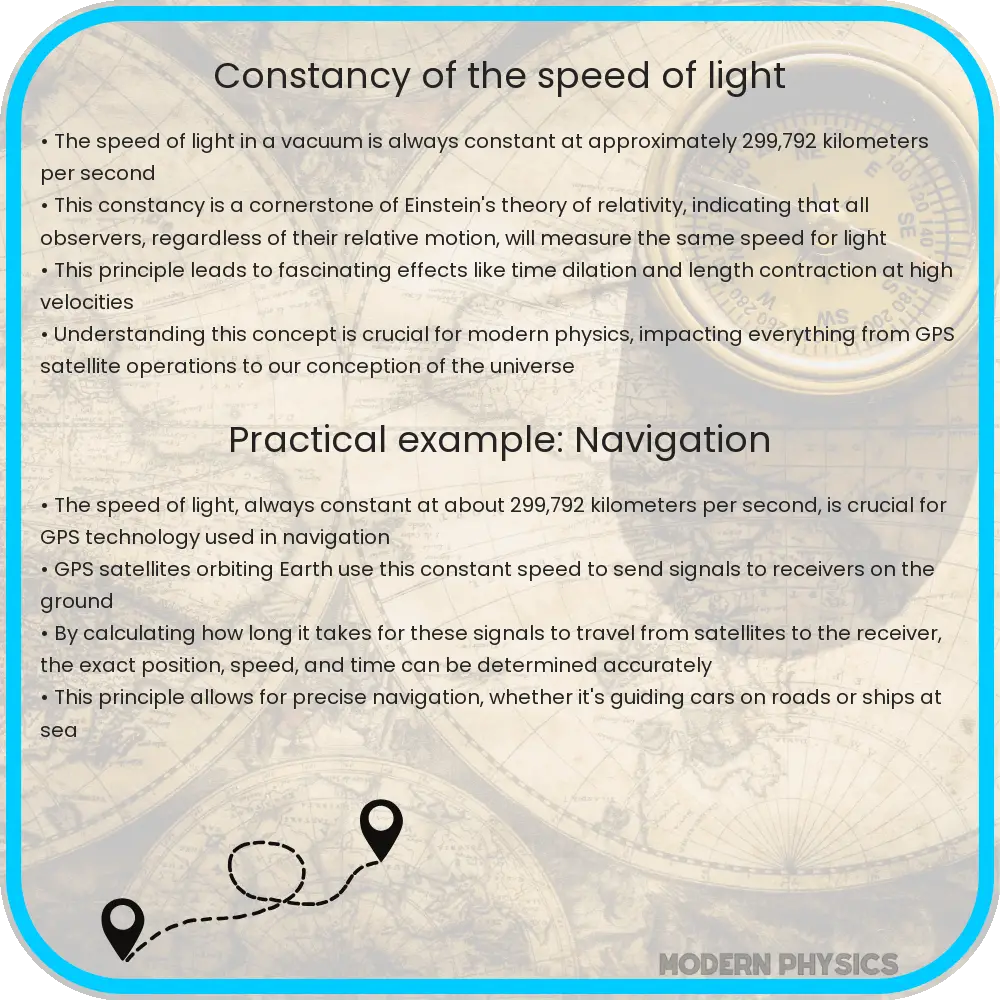Explore the constancy of light speed in Special Relativity and its impact on time, space, and causality, with insights into modern physics.

The Constancy of the Speed of Light: A Pillar of Special Relativity
One of the most profound insights in modern physics is the constancy of the speed of light, a cornerstone of Albert Einstein’s theory of Special Relativity. This concept not only revolutionized our understanding of time and space but also played a crucial role in shaping contemporary physics.
Understanding the Speed of Light
The speed of light in a vacuum is approximately 299,792,458 meters per second. Remarkably, this speed remains constant regardless of the observer’s motion or the light source. This invariance challenges the classical notions of absolute space and time, leading to groundbreaking implications in physics.
Invariance and the Lorentz Transformation
Special Relativity relies on the Lorentz transformation to reconcile the constancy of light speed with the principles of physics. These mathematical transformations demonstrate how measurements of time and space vary for observers in different states of motion. Crucially, they ensure that the speed of light remains constant in all inertial frames of reference.
Implications for Time and Space
The constancy of light speed leads to fascinating phenomena such as time dilation and length contraction. As an object approaches the speed of light, time appears to slow down from the perspective of a stationary observer, and the length of the object contracts in the direction of motion. These effects, though counterintuitive, have been experimentally verified, confirming Special Relativity’s predictions.
Impact on Causality and Physics
Special Relativity also imposes fundamental limits on causality and information transfer. No object or information can travel faster than light, ensuring causality – the principle that cause precedes effect. This limitation forms the basis of causality in physics and prevents paradoxes such as an effect preceding its cause.
In conclusion, the constancy of the speed of light is not just a simple physical constant; it is a fundamental aspect of the universe that shapes our understanding of time, space, and causality. Its implications extend far beyond the confines of physics, influencing a wide range of scientific and philosophical domains.
Special Relativity and Modern Physics
The principles of Special Relativity, founded on the constancy of light speed, have significantly influenced modern physics. They led to the famous mass-energy equivalence formula, E=mc2, highlighting the interconversion of mass and energy. This equation has profound implications, from explaining nuclear reactions to conceptualizing energy in cosmological phenomena.
Challenges to Intuition and Classical Mechanics
Special Relativity challenges our intuitive understanding of the universe, which is rooted in Newtonian mechanics. For example, the concept that the laws of physics are the same for all non-accelerating observers, regardless of their relative motion, defies our everyday experiences. This paradigm shift requires a rethinking of fundamental concepts like simultaneity and the absolute nature of time.
Integration with Quantum Mechanics
One of the ongoing challenges in physics is reconciling Special Relativity with quantum mechanics. While Special Relativity governs the large-scale structure of spacetime, quantum mechanics describes the probabilistic nature of particles at microscopic scales. Efforts to unify these theories have led to significant developments, including Quantum Field Theory and attempts at formulating a theory of Quantum Gravity.
Experimental Validation
Special Relativity is not just a theoretical construct; it has been validated by numerous experiments. From the observation of muon decay rates, which are consistent with time dilation, to the precision of the Global Positioning System (GPS), which incorporates relativistic corrections, empirical evidence robustly supports Einstein’s theory.
Conclusion
The constancy of the speed of light, as posited in Einstein’s Special Relativity, fundamentally alters our comprehension of the universe. It challenges traditional notions of time and space, imposes limits on causality, and underpins much of modern physics. The theory’s success lies not only in its radical departure from classical mechanics but also in its profound experimental validation. As our understanding of the universe continues to evolve, the principles of Special Relativity will undoubtedly remain an essential cornerstone, guiding future scientific inquiries and discoveries.
